This CE Center article is no longer eligible for receiving credits.
Most flooring is selected with two basic priorities: looks and affordability. Where money is no object, flooring might be chosen primarily for its aesthetic role in the overall design. Where cost is the main driver, a color will be picked at some point, but the selection is contingent upon the bottom line.

All images courtesy of Ecore International
Whatever the purpose of the space, the performance of the floor can improve the performance of the people working, playing, or living there, just as it is at the new Central Library in San Diego, pictured here.
In very specific applications, such as flooring for a surgical suite, an auditorium, or a basketball court, performance becomes an important issue, requiring adherence to established standards or technical guidelines. In the majority of spaces, however, the floor is taken for granted as a passive surface, not a performing one.
But that assumption is being challenged by new flooring products developed after extensive research, testing, and advances in materials and engineering. The right floor is an active surface that can do a lot more than look good or cover the slab inexpensively. The flooring in almost any space can make a positive contribution to the performance and well-being of the people using it, and if it doesn’t, that’s a wasted design opportunity with long-term negative impact.
So what is performance in flooring, and how can it be measured? There are specific characteristics that can guide designers to select the best floor for the space, not only for its looks and cost effectiveness but also for how well it performs.
This course will present a new working definition of good performance in a floor, what designers should demand, and how they can achieve it, focusing on three critical areas: acoustics, safety, and ergonomics. Each section will include a brief overview of what performance means in specific applications, followed by an explanation of key concepts, terms, and criteria to use when evaluating product options.
The course also introduces a new flooring technology specifically engineered to provide active surfaces with exceptional performance in a variety of applications. Especially in view of strong design trends to remove carpet and replace it with smooth surfaces, this new flooring can change expectations for what a flooring product should do—not just in traditional ways such as durability and maintenance but also in significantly improved safety, comfort, acoustics, and human performance.
Basics: What is a Performance Floor?
A performance floor can be defined as a surface that responds to the users in its environment in a way that supports and enhances their activities. Whatever the purpose of the space, the way the floor functions can improve the performance of the people working, playing, or living there. The key benefits fall into three major categories, all working together: safety, ergonomics, and acoustics.
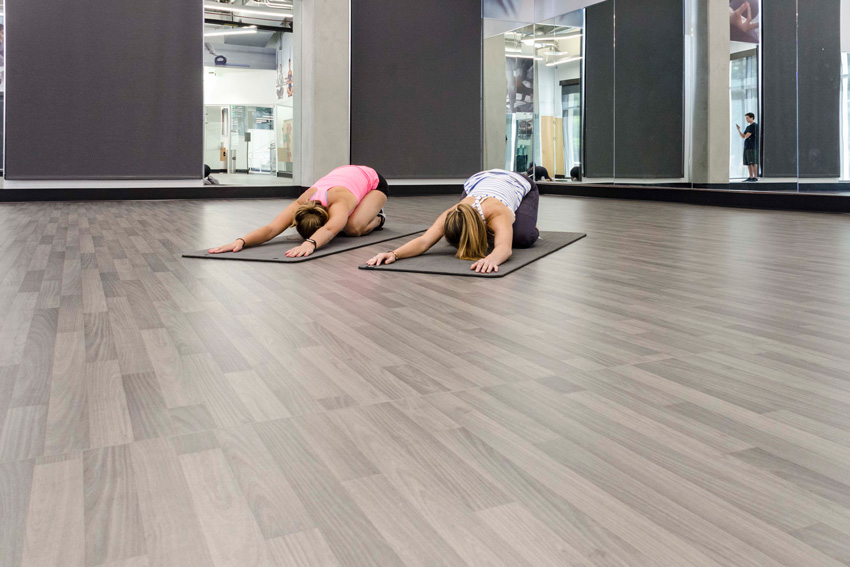
The new fitness center at USC Village Center, University of Southern California, Los Angeles, features an engineered performance surface with a natural woodgrain vinyl wear layer fusion bonded to a performance backing, which provides safety, ergonomic, and acoustic benefits.
For example, a performance surface in a hospital corridor would respond to footsteps, voices, and moving equipment by delivering the right combination of comfort and mobility to protect staff and sound control to protect patients from noise. The performance surface in a school corridor might be designed to respond to running school kids with a different combination of characteristics, perhaps more emphasis on protection from injury in case of a fall, while still isolating classrooms from the noise in the hall.
The precise composition of a performance floor can be tailored to react to the different needs of users in different spaces. At the same time, performance in almost every floor should also include durability and good environmental performance, measured by how long it will last until it needs replacing, how easy it is to maintain, and how sustainable the source materials and manufacturing are.
The basic options for flooring include:
Hard surfaces: For example, natural and manufactured wood, ceramic tile, laminate, terrazzo.
Soft surfaces: Primarily carpet.
Resilient surfaces: For example, linoleum, sheet vinyl, vinyl composition tile (VCT), cork sheets and tiles, rubber, and the new engineered surface discussed in this course.
Each type of flooring is useful for specific purposes, and each has disadvantages. Hard surfaces have aesthetic value and recently have been part of a style trend toward more streamlined modern interiors. But they tend to amplify noise, creating loud, confusing spaces, and they can present safety issues as well. Carpet tends to be more forgiving and can also muffle sound, but is difficult to clean and even more difficult to disinfect, disqualifying it for many applications such as health-care settings. Additionally, in busy applications like hospitality, carpet can look “dirty” even when it is well maintained. Many conventional resilient surfaces are easy to clean, and products are available in a range of prices and different levels of durability. But very few of these conventional surfaces can meet new acoustic, ergonomic, and safety performance expectations.
The engineered performance floors discussed in this course combine positive characteristics of hard, soft, and resilient surfaces. While there are high-performance homogeneous surfaces consisting of solid-composition rubber, in this course, we are specifically focusing on heterogeneous resilient floors composed of a surface-wear layer fusion bonded to a composition rubber base layer. The wear layer can be made of a variety of materials: no-wax vinyl, rubber, turf, carpet and others. The sustainable composition rubber base layer can be varied in structure and thickness to provide tailored performance characteristics. The fusion-bonding process creates a single, integrated product with broad application and design versatility.
The following are definitions of basic terms used in this course.
Key Flooring Material Terms
- Heterogeneous: A floor comprised of two different materials.
- Homogeneous: Flooring composed of only one material, e.g., a solid rubber floor with a similar color and pattern throughout the product.
- Vulcanization: a process using heat and chemicals to make natural or synthetic rubber durable enough for commercial use. All rubber products, including flooring, are made out of vulcanized rubber. See Making Rubber Better sidebar for more details.
- Composition rubber: product of a manufacturing process that incorporates rubber reclaimed from various post-consumer sources, granulated, cured, and combined under pressure with other active ingredients, to create a material with increased strength, durability, and scratch resistance.
- Engineered performance surface: a heterogeneous floor consisting of a wear layer fusion bonded to a composition rubber base layer, created with specific performance characteristics.
- Dual durometer: a term used in many industries to indicate a fusion of materials with different physical properties into one uniform product. The term is used by some flooring manufacturers to indicate flooring systems that combine a number of ergonomic benefits; for example, firm footing, shock absorption, and durability.
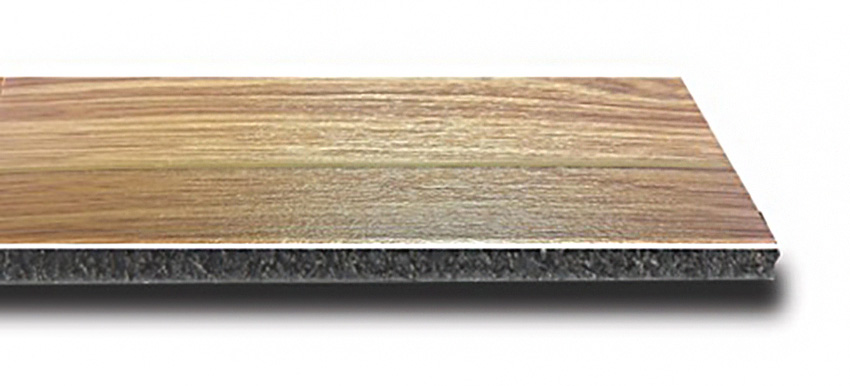
Shown is the cross-section of an engineered performance flooring product. A wide range of surfaces are available, and the thickness and properties of the performance layer can be tailored to different performance requirements.
“Calendared rubber” is a term used to describe another manufacturing process for a manufactured material comprised of vulcanized synthetic rubber. In this process, rubber is poured into a mold and then rolled into a sheet or cut into tiles. With this rolling method, performance characteristics tend to be lost, and the product can scuff and scratch more easily, typically requiring a finish in order to avoid maintenance challenges.
Most flooring is selected with two basic priorities: looks and affordability. Where money is no object, flooring might be chosen primarily for its aesthetic role in the overall design. Where cost is the main driver, a color will be picked at some point, but the selection is contingent upon the bottom line.

All images courtesy of Ecore International
Whatever the purpose of the space, the performance of the floor can improve the performance of the people working, playing, or living there, just as it is at the new Central Library in San Diego, pictured here.
In very specific applications, such as flooring for a surgical suite, an auditorium, or a basketball court, performance becomes an important issue, requiring adherence to established standards or technical guidelines. In the majority of spaces, however, the floor is taken for granted as a passive surface, not a performing one.
But that assumption is being challenged by new flooring products developed after extensive research, testing, and advances in materials and engineering. The right floor is an active surface that can do a lot more than look good or cover the slab inexpensively. The flooring in almost any space can make a positive contribution to the performance and well-being of the people using it, and if it doesn’t, that’s a wasted design opportunity with long-term negative impact.
So what is performance in flooring, and how can it be measured? There are specific characteristics that can guide designers to select the best floor for the space, not only for its looks and cost effectiveness but also for how well it performs.
This course will present a new working definition of good performance in a floor, what designers should demand, and how they can achieve it, focusing on three critical areas: acoustics, safety, and ergonomics. Each section will include a brief overview of what performance means in specific applications, followed by an explanation of key concepts, terms, and criteria to use when evaluating product options.
The course also introduces a new flooring technology specifically engineered to provide active surfaces with exceptional performance in a variety of applications. Especially in view of strong design trends to remove carpet and replace it with smooth surfaces, this new flooring can change expectations for what a flooring product should do—not just in traditional ways such as durability and maintenance but also in significantly improved safety, comfort, acoustics, and human performance.
Basics: What is a Performance Floor?
A performance floor can be defined as a surface that responds to the users in its environment in a way that supports and enhances their activities. Whatever the purpose of the space, the way the floor functions can improve the performance of the people working, playing, or living there. The key benefits fall into three major categories, all working together: safety, ergonomics, and acoustics.

The new fitness center at USC Village Center, University of Southern California, Los Angeles, features an engineered performance surface with a natural woodgrain vinyl wear layer fusion bonded to a performance backing, which provides safety, ergonomic, and acoustic benefits.
For example, a performance surface in a hospital corridor would respond to footsteps, voices, and moving equipment by delivering the right combination of comfort and mobility to protect staff and sound control to protect patients from noise. The performance surface in a school corridor might be designed to respond to running school kids with a different combination of characteristics, perhaps more emphasis on protection from injury in case of a fall, while still isolating classrooms from the noise in the hall.
The precise composition of a performance floor can be tailored to react to the different needs of users in different spaces. At the same time, performance in almost every floor should also include durability and good environmental performance, measured by how long it will last until it needs replacing, how easy it is to maintain, and how sustainable the source materials and manufacturing are.
The basic options for flooring include:
Hard surfaces: For example, natural and manufactured wood, ceramic tile, laminate, terrazzo.
Soft surfaces: Primarily carpet.
Resilient surfaces: For example, linoleum, sheet vinyl, vinyl composition tile (VCT), cork sheets and tiles, rubber, and the new engineered surface discussed in this course.
Each type of flooring is useful for specific purposes, and each has disadvantages. Hard surfaces have aesthetic value and recently have been part of a style trend toward more streamlined modern interiors. But they tend to amplify noise, creating loud, confusing spaces, and they can present safety issues as well. Carpet tends to be more forgiving and can also muffle sound, but is difficult to clean and even more difficult to disinfect, disqualifying it for many applications such as health-care settings. Additionally, in busy applications like hospitality, carpet can look “dirty” even when it is well maintained. Many conventional resilient surfaces are easy to clean, and products are available in a range of prices and different levels of durability. But very few of these conventional surfaces can meet new acoustic, ergonomic, and safety performance expectations.
The engineered performance floors discussed in this course combine positive characteristics of hard, soft, and resilient surfaces. While there are high-performance homogeneous surfaces consisting of solid-composition rubber, in this course, we are specifically focusing on heterogeneous resilient floors composed of a surface-wear layer fusion bonded to a composition rubber base layer. The wear layer can be made of a variety of materials: no-wax vinyl, rubber, turf, carpet and others. The sustainable composition rubber base layer can be varied in structure and thickness to provide tailored performance characteristics. The fusion-bonding process creates a single, integrated product with broad application and design versatility.
The following are definitions of basic terms used in this course.
Key Flooring Material Terms
- Heterogeneous: A floor comprised of two different materials.
- Homogeneous: Flooring composed of only one material, e.g., a solid rubber floor with a similar color and pattern throughout the product.
- Vulcanization: a process using heat and chemicals to make natural or synthetic rubber durable enough for commercial use. All rubber products, including flooring, are made out of vulcanized rubber. See Making Rubber Better sidebar for more details.
- Composition rubber: product of a manufacturing process that incorporates rubber reclaimed from various post-consumer sources, granulated, cured, and combined under pressure with other active ingredients, to create a material with increased strength, durability, and scratch resistance.
- Engineered performance surface: a heterogeneous floor consisting of a wear layer fusion bonded to a composition rubber base layer, created with specific performance characteristics.
- Dual durometer: a term used in many industries to indicate a fusion of materials with different physical properties into one uniform product. The term is used by some flooring manufacturers to indicate flooring systems that combine a number of ergonomic benefits; for example, firm footing, shock absorption, and durability.

Shown is the cross-section of an engineered performance flooring product. A wide range of surfaces are available, and the thickness and properties of the performance layer can be tailored to different performance requirements.
“Calendared rubber” is a term used to describe another manufacturing process for a manufactured material comprised of vulcanized synthetic rubber. In this process, rubber is poured into a mold and then rolled into a sheet or cut into tiles. With this rolling method, performance characteristics tend to be lost, and the product can scuff and scratch more easily, typically requiring a finish in order to avoid maintenance challenges.
Performance Flooring: Acoustics

In the Paseo Verde Library in Las Vegas, an adjacent cafe presented noise and maintenance challenges. An engineered performance surface was selected to replace difficult-to-maintain carpet and ensure that the library remained quiet.
As occupant health and wellness become ever more important aspects of the built environment, ensuring good acoustics should be a fundamental part of the design process. Acoustics can affect a building occupant’s experience in many ways, including stress from noise, sleep disturbance, worker productivity, speech intelligibility, privacy, and patient outcomes in hospitals. The flooring choice is a vital consideration for good acoustics and contributes greatly to the control of impact noise from footsteps, dropped items, dragging chairs, fitness areas, and more.
In the past, carpet was a common flooring choice for apartments, hotels, offices, and schools. The soft nature of carpet greatly reduces impact noise, and its common use meant that impact noise was not a major issue. As designers move more and more to a modern aesthetic that minimizes carpet and instead emphasizes hard floor surfaces, impact noise has become a much more critical consideration. Other flooring materials are needed to supplement the standard hard flooring surfaces and provide the impact insulation once taken for granted with carpet.
For example, acoustics were obviously a prime consideration when new surfacing was selected to replace shredded and discolored 12-year-old carpet in the Paseo Verde Library in Las Vegas. The engineered performance surface selected is “just as quiet as carpet,” says Joan Dalusung, manager of the Paseo Verde Library. “We have been very happily surprised about that. It’s not just people walking across it; we are constantly rolling book carts and small furniture over it, and it has not only held up wonderfully, but the space has remained quiet. It has surpassed our expectations on an acoustic level.”
A growing trend toward more prevalent and expansive fitness facilities means they are now more often located near noise-sensitive spaces, such as hotel rooms, apartments, offices, conference rooms, and classrooms. A traditional stand-alone gym may not produce many acoustical issues, but a large fitness center located above guestrooms in a high-end hotel can present major issues for noise control.
In all these instances, proper flooring selection is a critical part of achieving the project design goals. With regard to acoustics, performance flooring primarily serves to reduce the sound from impacts (footsteps, weight drops, etc.) and other floor interactions (dragging a chair, rolling carts, rolling hospital beds, etc.). Performance flooring does this in two main areas:
- Rooms outside the space where the impacts or floor interactions occur. The most common example is the noise from footsteps in an upper apartment affecting the downstairs neighbor. However, other impacts, such as dropping heavy weights in a gym, can affect spaces below, beside, and above where the impact occurs. Noise from footfalls is commonly addressed using the impact insulation class (IIC) and ΔIIC ratings. IIC is a single-number rating that indicates the amount of impact insulation provided by a floor-ceiling assembly. Delta IIC (written as ∆IIC) is a measure of the improvement from adding flooring and/or underlayment to a bare concrete slab.
- Rooms where the impacts or floor interactions occur. This is a major issue in health-care facilities where noise from footsteps and rolling carts in the hallway can have a major impact on a patient’s ability to relax, sleep, and heal. Other examples are performing-arts venues and churches where carpet has typically been used in the aisles to reduce noise from people’s movement. There is currently no industry standard to measure surface-generated noise, though one is under development by ASTM.
Acoustical underlayments are the most common method of improving the impact noise reduction of a floor. They can be placed directly beneath the finished floor or between the subflooring and a gypsum concrete topping, for instance. As discussed in this course, new engineered surface products include an acoustical underlayment fusion bonded to the underside of the finish flooring. These engineered surfaces can reduce impact noise transmitted to adjacent spaces as well as surface-generated noise within the space where the impact occurs.
Standard acoustical underlayments used to address transmission of impact noise to adjacent spaces are usually less than half an inch thick and measured using the IIC and ΔIIC ratings. These can be very effective for reducing footfall noise, but they are generally insufficient when trying to control noise from heavy-weight impacts in gyms and the like. To effectively reduce impact noise from heavy weights, far more robust flooring solutions are needed. There are rollout flooring products and flooring tiles specifically designed to address heavy-weight impacts. These products are significantly thicker (up to 2.5 inches and more) than standard underlayments and provide substantial deflection to help absorb the energy of the weight impact. Careful use of these products can help address noise complaints when fitness areas are located near noise-sensitive spaces, such as hotel rooms and apartments. The ΔIIC and IIC tests use light weights (0.5 kilogram, or roughly 1 pound), resulting in an inaccurate indication of a floor’s performance under heavy-weight impacts, like those experienced in a gym and other fitness areas. Presently, there is no recognized standard for testing heavy-weight impacts, so designers should gather as much information as possible when comparing weight impact data from different manufacturers.
Although there is currently no standard test for surface-generated noise, in general, softer flooring generates less noise than hard flooring. A good example is the difference between a dog running on carpet and a dog running on hardwood flooring. On a hardwood floor, one can clearly hear the clatter of the dog’s nails hitting the floor, but on carpet, this sound is mostly absent. Some resilient flooring surfaces are engineered for noise control similar to soft surfaces like carpet.
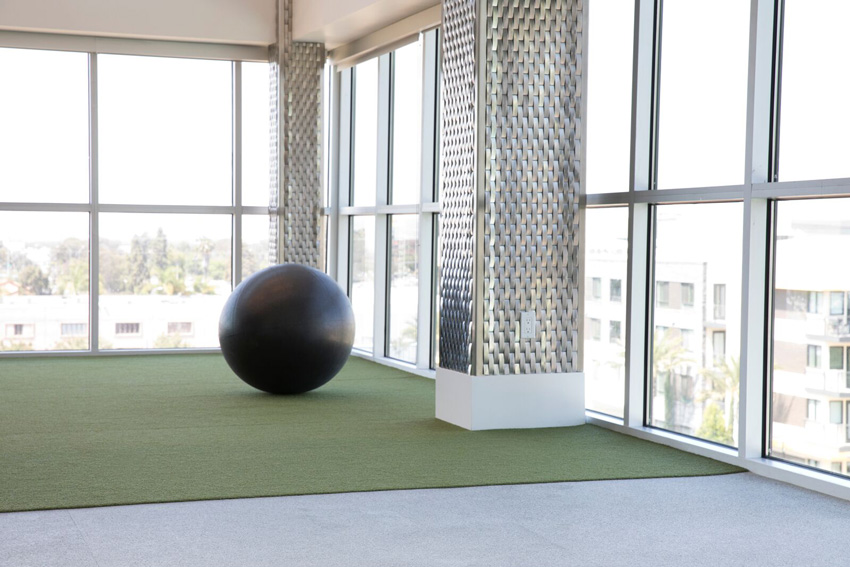
As urban density increases, fitness facilities are frequently located near noise-sensitive spaces, such as hotel rooms, apartments, offices, conference rooms, and classrooms. Pictured here is Vive on the Park, an upscale apartment complex in San Diego featuring a gym over apartments. Several engineered surfaces with composition rubber backing were used in this space, protecting occupants from noise while coordinating with the sleek, contemporary styling of the rest of the building.
Many designers are familiar with the acoustical requirements (STC and IIC 50) incorporated in the building code for multifamily residential buildings: ICC G2 – 2010 Guideline for Acoustics. These requirements are typically included in municipal building codes and are therefore usually a legal requirement for multifamily construction. There are many other acoustical standards for various building types that may be less commonly known, including health care, education, and hospitality. Many hotel chains have their own development standards that include acoustical requirements.
Whatever the project type, it is imperative that designers are aware of any and all acoustical performance standards that apply to the project, and manufacturers should be able to help evaluate flooring products that will contribute to meeting those standards. For example, manufacturers of effective, properly tested flooring products should be able to provide both IIC and ∆IIC numbers, as well as data on alternative assemblies, so designers can make a realistic comparison based on accurate predictions of performance.
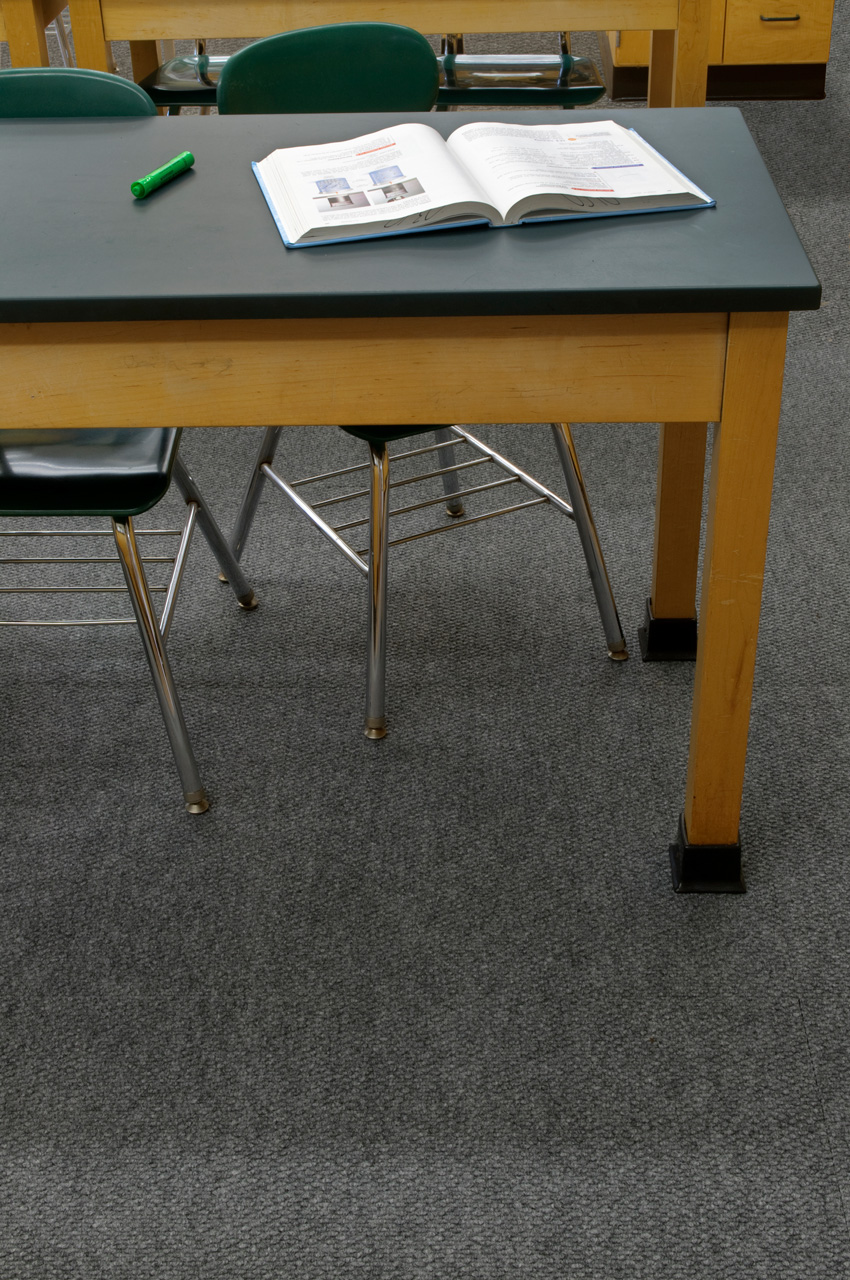
In the past, carpet was a common flooring choice to reduce impact noise. This performance floor in the Lancaster Country Day School in Lancaster, Pennsylvania, features a carpet wear layer fusion bonded to a composition rubber backing, improving the acoustic, ergonomic, and safety performance of the flooring.
Key Acoustics Terms and Criteria
- Impact insulation class (IIC): Based on ASTM E492: Standard Test Method for Laboratory Measurement of Sound Transmission Through Floor-Ceiling Assemblies Using the Tapping Machine. A measure of the reduction of impact noise provided by a floor-ceiling assembly.
- Delta IIC (∆IIC): Based on ASTM E2179: Standard Test Method for Laboratory Measurement of the Effectiveness of Floor Coverings in Reducing Impact Sound Transmission Through Concrete Floors. A measure of the improvement from adding the flooring and/or underlayment to a bare concrete slab. The ∆IIC rating gives a more precise idea of what a product might add to a floor-ceiling assembly.
- Sound transmission class (STC): Based on ASTM E90: Standard Test Method for Laboratory Measurement of Airborne Sound Transmission Loss of Building Partitions and Elements. Higher values are better, as they indicate less transmission of airborne sound. STC is generally not affected significantly by floor coverings and underlayments.
- Surface-generated noise: A new measurement being considered for adoption by ASTM, establishing methods of quantifying how significantly flooring reduces impact sound levels in the space where the impacts occur.
- International Code Council: ICC G2 – 2010 Guideline for Acoustics, adopted by many local jurisdictions.
- The American National Standards Institute (ANSI) and the Acoustical Society of America (ASA) have published performance criteria for schools, particularly ANSI/ASA S12.60-2010.
Performance Floors: Ergonomics
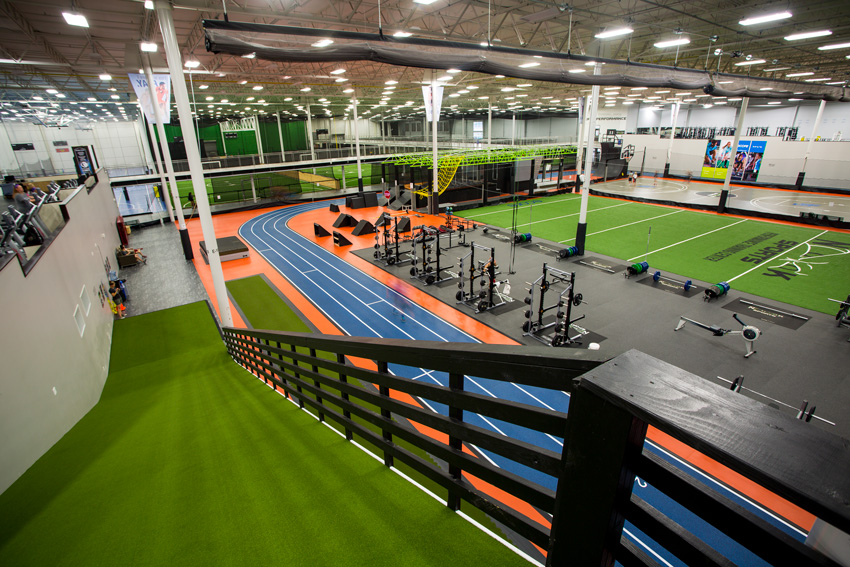
Spooky Nook Sports, in Manheim, Pennsylvania, the largest indoor sports complex in North America, uses different performance flooring solutions for areas with different functions.
“Ergonomics” is a broad term with many meanings in different settings, but however it is defined, the mechanics of how the human body reacts to surrounding physical conditions has real consequences for the health and productivity of people in all activities, from standing in an office workspace to exercising in a gym. An ergonomic chair is designed to support the body in ways that avoid injury and promote healthy posture. What is an ergonomic floor?
A performance surface can provide support, prevent fatigue and injury, and promote good mobility. As with other elements of performance, the balance depends on the activities in the space. For example, a very soft, cushioned floor in a hospital corridor might be extremely comfortable for staff—as long as they just stand there. But since most of the day they are actually moving quickly and pushing or pulling heavy equipment, an overly soft floor would be an unsafe nuisance. Ergonomically efficient flooring balances the absorption of force and the return of energy.
The classic comparison illustrating these concepts is a floor of concrete versus a beach of sand. Concrete has very little force reduction (-1.9 percent) and very high energy restitution (77.2 percent). In the case of a footstep, this means that the floor returns virtually all the force of the footstep to the feet, legs, and body of the walking person. Concrete is hard and uncomfortable and has no “give.”
At the opposite end of the spectrum, sand has very high force reduction (82.7 percent) and very low energy restitution (0.5 percent). Virtually no energy is returned to the person, it is all absorbed, there is too much “give,” and walking becomes very difficult.
Force reduction and shock absorption tend to add levels of safety, while energy restitution and “bounce” enhance performance and durability. For any given application, the ideal surface for the space will achieve the right balance between the two.
For example, trends in fitness are moving toward functional training, which focuses on strength and conditioning—jumping, sprinting, throwing, and crawling. The ability to customize performance for activities in spaces with specific purposes was important when Spooky Nook Sports, the largest indoor sports complex in North America, renovated six tennis courts to create a functional training area that includes a performance track, turf field, basketball court, weight-lifting area, and many other specialized spaces such as sled lanes and obstacle courses, all with different performance surfaces supporting different activities. The basketball court surface, for example, is an engineered floor with a surface that mimics real wood but is more durable and features a composition rubber backing. In the new weight-lifting area, fitted with cutting edge inlaid lifting platforms, the surface is a 22.5-millimeter system comprised of three layers of composition rubber to ensure good force reduction and energy restitution.
Flooring concepts such as coefficient of friction (COF), sliding effect, vertical deformation, and others discussed in the next section on safety are also closely related to ergonomic performance. It is important to balance the physical characteristics of the flooring based on the specific needs of the space for safety, mobility, and ergonomic response.
Key Ergonomics Terms and Criteria
- Force reduction: How much energy a surface absorbs; for example, when a person walks on it. A surface of concrete would have extremely low force reduction because it absorbs very little energy, returning most of it back to the person’s feet, legs, and body.
- ASTM F2569 – 11: Standard Test Method for Evaluating the Force Reduction Properties of Surfaces for Athletic Use.
- Energy restitution: How much the surface returns energy. A surface of sand has very little energy restitution and a high force reduction, meaning it will absorb almost all the energy and return very little back to the person’s body, making walking difficult.
- Elasticity: A term often used to evaluate sports flooring, indicating how the surface responds to an athlete. The basic types are area elasticity, where the downward force of a footfall (for example, a basketball player’s sneaker) is dispersed over a wide area, and point elasticity, where the force (for example, from a high heel shoe) would be concentrated in a smaller area. There are also combination floors with levels of both types of elasticity.
Performance Floors: Safety
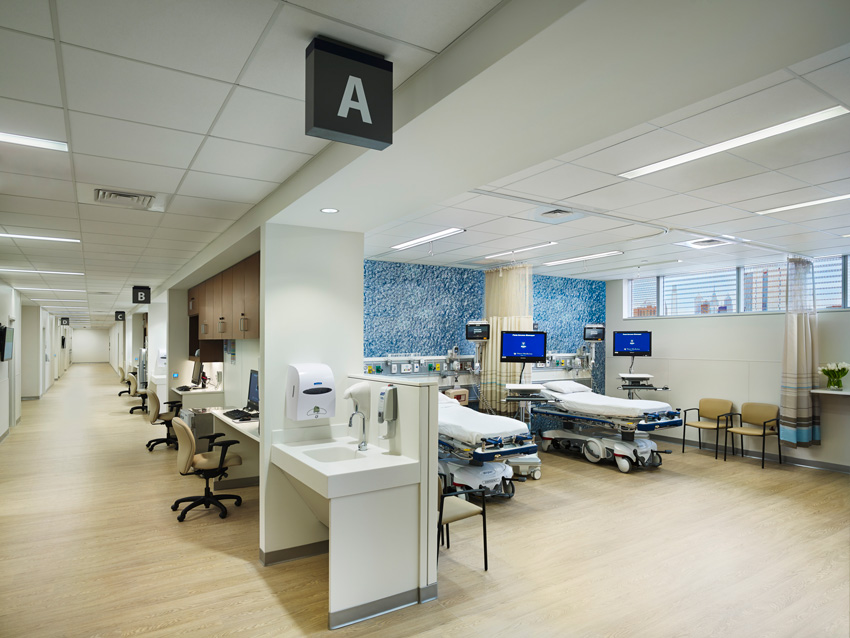
Today, more people are more active, a positive development in society. But more activity means more falls. Flooring can reduce the force of impact and help to prevent falls and mitigate injury when falls do occur. Shown here is the engineered performance flooring in Pennsylvania Presbyterian Medical Center, Philadelphia.
The term “safety floor” typically refers to flooring used to improve traction in areas that are likely to be exposed to water, food, or chemicals, such as industrial spaces, commercial kitchens, pools, or spas. But safety is also a much broader category of performance, and it is a vital concern in almost every kind of space. For example, in the hospitality industry, a range of indoor and outdoor activities and playgrounds have become an essential offering by most hotels today, a major part of what they are doing to increase the wellness and satisfaction of guests. It becomes critical to the company’s operation to protect these guests.
In some applications, safety receives even greater emphasis, such as flooring for schools, hospitals, athletic facilities, and many different types of rehabilitation, independent, and assisted living facilities. A performance floor should contribute to reducing impact hazards in the space, balanced with enhancing the ability of people to move freely.
Floors can also be designed for other uses that relate to safety. Changes of color and pattern can be designed to indicate changes of level, aid in wayfinding, or assist people with visual impairments. Floors are major components of design in health-care environments, where the creative use of color and beauty has been proven to enhance patient experience, support healing, and improve outcomes.
Slip resistance, often measured by COF, is probably the most familiar component of safety performance in flooring and one of the most important for selecting flooring that reduces the likelihood of a fall by preventing slips. Collectively, the flooring industry has made significant strides bringing down the number of falls. But falls do inevitably occur, and since they can never be eliminated entirely, a performance floor should also work to prevent injury or reduce its severity.
At the same time, depending on the exact application, a surface that is too slip resistant can be inefficient and present a safety hazard of its own when it impedes movement. The users of a gym, dance floor, corporate lobby, retail store, or classroom will need support and protection with different balances of slip resistance and mobility.
Concepts often used in specifying surfaces for sports, fitness, and athletics, such as playability, sliding effect, and head injury criterion, are useful in thinking about surfaces in many other types of spaces too. For example, standards for sports surfaces describe criteria for measuring factors in addition to COF, such as sliding effect, shock absorption, vertical deformation, and ball bounce. These characteristics affect both safety and playability—a player’s stability and freedom of movement. The concept of playability is a useful idea when evaluating how suitable a floor will be for the specific activities in the space.
Today, more people are more active, an extremely positive development in society. But more activity comes with more falling; this is as human as kids learning to walk. “The floor can make an immense and possibly life-changing difference in preventing and mitigating injury,” says Mark Huxta, director of health-care sales for Ecore.
Safety performance is also closely related to ergonomic performance. For example, when Johns Hopkins Hospital in Baltimore decided to replace carpet throughout its facilities, it conducted a system-wide, multidisciplinary research floor testing study in 2014–2015, comparing 20 products according to numerous criteria, including reduction of risk of injury associated with falls, sound control, sustainability, effective cleaning, comfort underfoot, and many others. The surface selected for inpatient rooms in the JHH Meyer Neuro & Rehab facility is an engineered surface of vinyl sheet fusion-bonded to a 5-millimeter composition rubber backing.
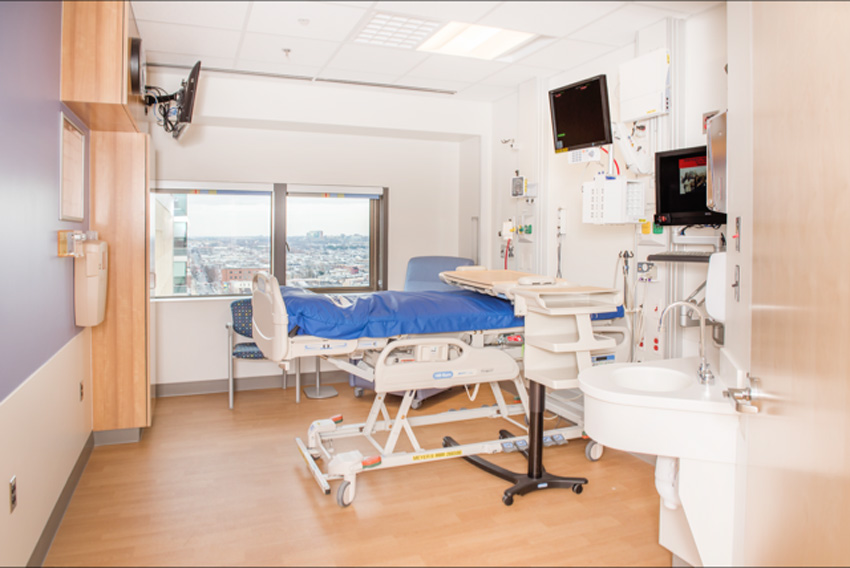
The engineered flooring surface at JHH Meyer Neuro & Rehab facility in Baltimore features vinyl fusion bonded to composition rubber backing.
The following are key terms and criteria for evaluating safety performance in flooring. Many also apply to ergonomic performance, discussed in the section above. In some applications, specific scores or ratings may be required. In others, manufacturers should be able to discuss how these concepts can inform the comparison of different flooring products.
Key Safety Terms and Criteria
- Coefficient of friction (COF): A measure of slip resistance, part of an overall consideration of how people will use the surface, to ensure both safety and ease of movement. In the United States, the most common test method for resilient floors is ASTM D2047. The pendulum standard first developed in Britain has become the basis for national slip resistance standards in many countries but is not yet used widely in the United States. Measuring slip resistance precisely is a subject of ongoing discussion. Flooring manufacturers should be able to offer information about test methods used to measure the performance of their products.
- Sports floor classes: ASTM F2772: Standard Specification for Athletic Performance Properties of Indoor Sports Floor Systems establishes criteria for sports or multipurpose flooring, defining classifications from Class 1 to 5, according to shock absorption, vertical deformation, ball bounce, and sliding effect. Class 1 is not necessarily “better” in an absolute sense. For example, a rigorously designed competitive professional basketball court might be a Class 2 because of the overall balance of considerations and the nature of the play and the players.
- Ball bounce: The higher a ball will rebound, the better the playability. In the surface testing process, a ball is dropped from a given height onto a surface and must bounce back at a certain required height in order to be approved for play.
- Sliding effect: How a surface prevents slipping but allows for safety of movement.
- Vertical deformation: How much the floor will deform, or “give” on impact. Measures the deflection of a surface during an entire impact. Also referred to as a “stiffness test,” a measure of foot stability, indicating what a person feels on his or her feet. An important criterion in health-care settings to gauge how easily and safely staff will be able to maneuver beds and equipment like rolling carts.
- Head injury criterion (HIC): A measure of the likelihood of head injury arising from an impact. The HIC can be used to assess safety in many different areas, such as vehicles, personal protective gear, sports equipment, and surfaces. For playing surfaces, the HIC test measures the force of a human head when it strikes the surface. The higher the Critical Fall Height (CFH), in meters, the more protective the surface. For example, a CFH rating of 6 means the surface is equipped to reduce the likelihood of an injury occurring from up to a 6-foot fall. The higher the CFH rating, the safer the surface.
- G-Max: A measure of how field surfaces (typically synthetic) perform in terms of impact attenuation or shock absorption. ASTM Standard F355-A and ASTM Specification F1936 tests measure how many Gs (gravitation-force, basically measuring acceleration) a surface can absorb upon impact. For example, in the case of a playing field, higher G-max means the surface absorbs less impact and returns more to the player. A lower G-max score reduces the likelihood of injury.
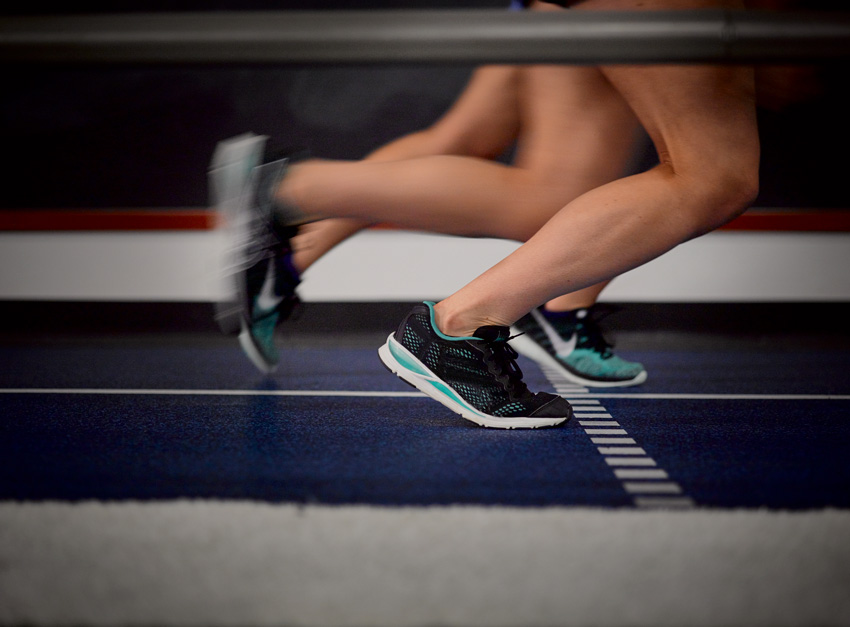
Concepts often used in specifying surfaces for sports, fitness, and athletics, such as playability, sliding effect, and head injury criterion, are useful in thinking about surfaces in other types of spaces.
What Can A Floor Do?
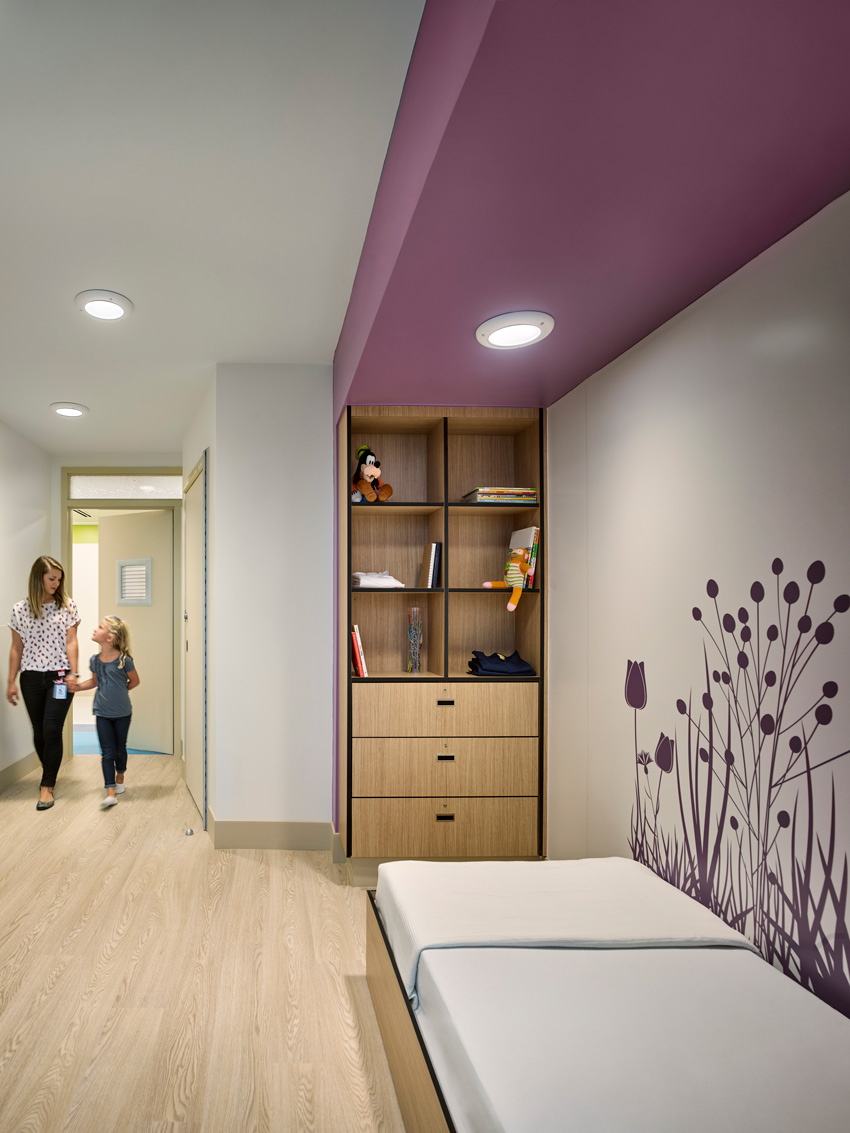
Every floor should make a positive contribution to the performance and well-being of the people using it.
As discussed in this course, a thoughtfully designed floor using state-of-the-art advances in materials and manufacturing can “do” quite a lot in terms of safety, ergonomics, and acoustics. A performance floor is a surface that responds to the users in its environment in ways that support and enhance their activities.
At the same time, these floors still need to meet the most fundamental requirements of premium flooring in all types of interiors. In addition to adding new performance capabilities, the quality of flooring products should also be evaluated by traditional measures of performance, including:
- Aesthetics and design versatility: New performance flooring offers a wider variety of design possibilities because the wear surface can be composed of many different materials, including vinyl, rubber, turf, and carpet, in an almost unlimited range of finishes, colors, patterns, and textures, from floors that reproduce natural wood grains to floors with custom-designed graphics.
- Durability: Long-term performance with low need for replacement. Performance flooring can be selected with increased energy restitution for durability under particularly demanding conditions, such as high-impact weights or high traffic.
- Maintenance: Performance flooring products are available with a factory-applied reinforcing finish that provides polish-free maintenance for the lifetime of the product. Performance flooring helps manage life-cycle costs while assuring clean, sterile environments where necessary.
- Sustainable life cycle and visible corporate commitment to environmental responsibility. Some of the major criteria for assessing sustainable performance flooring products include:
- Contribution to LEED points by meeting criteria under Material and Resources and Indoor Environmental Quality categories;
- FloorScore rating;
- Environmental product declarations (EPDs); and
- Participation in the Mindful Materials program, a design industry initiative that provides a single common platform for manufacturers to communicate—and designers to access—information such as disclosure documents and certifications for specific products.

|
At Ecore, we are driven by this question: Can a floor do more? We believe the answer is YES! We are building our company and the products we offer based on the simple notion that floors should elevate beyond current expectations. We engineer performance well beyond industry standards related to acoustics, ergonomics, and safety.
www.ecoreintl.com
|
























